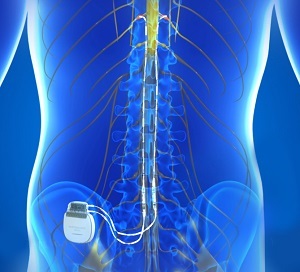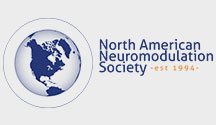
What is Spinal Cord (DCS) and Peripheral Stimulation?
Dorsal column spinal cord stimulation (DCS) is a therapy to treat certain chronic intractable pain conditions using an implantable neuromodulation device called a dorsal column stimulator (DCS) or spinal column/cord stimulator. The device sends electrical impulses to the areas of the spinal cord causing pain and interferes with the transmission of pain signals to the brain. As it blocks the brain's ability to sense pain in the stimulated areas, it works to reduce the frequency, duration, and intensity of pain.
Peripheral nerve stimulation, commonly known as PNS, is a technique employed in the treatment of certain chronic pain conditions. The technique involves placement of a small electrical device or electrodes along the course of the peripheral nerves, found outside of the brain and spinal cord, to manage pain. Peripheral nerve stimulation differs from spinal cord stimulation as the stimulating device is placed next to one of the peripheral nerves at the targeted pain area and not on the spinal cord where the nerve originates.
Indications for Spinal Cord (DCS) and Peripheral Stimulation
Spinal cord (DCS) and peripheral stimulation can be indicated to treat a number of painful conditions such as:
- Nerve injuries from previous surgery or trauma
- Complex regional pain syndrome
- Long-term back pain associated with cluneal nerves (nerves of the buttocks)
- Occipital neuralgia/chronic persistent headaches
- Arachnoiditis – a painful inflammatory condition of the spinal cord
- Nerve entrapment
- Chronic arm or leg (sciatica) pain
- Other painful conditions such as angina, stump pain, or spinal cord injury
- Conservative treatment measures have failed to relieve pain
Preparation for Spinal Cord (DCS) and Peripheral Stimulation
Pre-procedure preparation for spinal cord (DCS) and peripheral stimulation will involve the following steps:
- A thorough examination by your doctor is performed to check for any medical issues that need to be addressed prior to surgery.
- Depending on your medical history, social history, and age, you may need to undergo tests such as blood work and imaging to help detect any abnormalities that could threaten the safety of the procedure.
- You will be asked if you have allergies to medications, anesthesia, or latex.
- You should inform your doctor of any medications, vitamins, or supplements that you are taking.
- You should refrain from medications or supplements such as blood thinners, aspirin, or anti-inflammatory medicines for 1 to 2 weeks prior to surgery.
- You should refrain from alcohol or tobacco at least a week before and two weeks after surgery.
- You should not consume any solids or liquids at least 8 hours prior to surgery.
- You will be instructed to shower with an antibacterial soap the morning of surgery to help lower your risk of infection after surgery.
- Arrange for someone to drive you home as you will not be able to drive yourself after surgery.
- A written consent will be obtained from you after the surgical procedure has been explained in detail.
Procedure for Spinal Cord (DCS) and Peripheral Stimulation
Nerve stimulation device placement involves a two-step process. Before implanting a permanent device, you will undergo a trial stimulation period to see if the stimulation helps relieve the pain. If it does, a permanent stimulator can be implanted. Most nerve stimulation procedures are performed as an outpatient (same day) minimally invasive surgery under local anesthetic.
A dorsal column stimulator consists of electrodes, a battery-operated pulse generator, a remote-control device, and connecting wires. Depending on the location of your pain, the electrodes are placed in the neck, upper or lower back region of the spinal cord either surgically or through the skin under radiographic guidance. The remaining components are connected externally. When turned on, thin wires transfer current from the pulse generator to the nerve fibers of the spinal cord which stimulates nerves in the region where pain is perceived. Electrical impulses alter and mask the pain signals from extending to your brain thereby reducing pain.
Peripheral nerve stimulation (PNS) device placement procedure involves making a small surgical cut under X-ray guidance and placing an electrical device or electrode over the targeted pain area. When pain flares up, the electrodes are turned on with the remote provided to send a weak electrical current to the nerve, which the patient experiences as a mild tingling sensation. By stimulating a non-painful sensory pathway, the electrical impulse deceives the brain into switching off or notably diminishing the pain signals to provide pain relief.
Postoperative Care and Recovery
In general, postoperative care instructions and recovery after spinal cord (DCS) and peripheral stimulation will involve the following steps:
- You will be transferred to the recovery area where your nurse will closely observe you for any allergic/anesthetic reactions and monitor your vital signs as you recover.
- Most patients can go home the same day of the surgery
- Your device will be calibrated to the appropriate settings before leaving.
- You may experience pain, inflammation, and discomfort in the operated area.
- Application of cold and heat therapy on the operated area may be recommended to reduce inflammation and pain.
- Instructions on surgical site care and bathing will be provided.
- A periodic follow-up appointment will be scheduled to monitor your progress.
Benefits of Spinal Cord (DCS) and Peripheral Stimulation
Some of the benefits of spinal cord (DCS) and peripheral stimulation include:
- Reduced narcotic or opioid use
- Minimal muscle trauma
- Fast recovery
- Same-day discharge to home
- Cost-effective
- Minimal side effects
- Targeted pain relief
- Reduced need for oral pain medicines
- High patient satisfaction
- Improved quality of life
Risks and Complications
Spinal cord (DCS) and peripheral stimulation is a relatively safe procedure; however, as with any surgery, some risks and complications may occur.
General risks of any surgery include:
- Infection
- Blood clots
- Blood loss
- Anesthetic reactions
Risks and complications specific to stimulation device include:
- Persistent pain at the implant site
- Cerebrospinal fluid leakage
- Battery leakage/battery failure
- Hematoma
- Seroma
- Epidural hemorrhage
- Allergic reaction to implant materials
- Skin erosion
Related Topics
- Spinal Cord Stimulator
- Spinal Cord (DCS) & Peripheral Stimulation
- Neuromodulation
- Spine Injections
- Epidural Spinal Injection
- Caudal Epidural Injection
- Transforaminal Epidural Block
- Spinal Nerve Blocks
- Facet Injections
- Medial Branch Block Injections
- Radiofrequency Ablation
- Piriformis Muscle Injection
- Costo-vertebral Joint Injection
- Dorsal Column Stimulator









